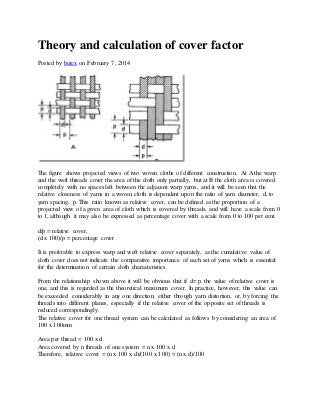Theory and calculation of cover factor
•Download as DOCX, PDF•
3 likes•1,205 views
Theory and calculation of cover factor
Report
Share
Report
Share

Recommended
Recommended
More Related Content
Viewers also liked
Viewers also liked (19)
Environmental Science (EVS) : Houses and Clothing (Class II)

Environmental Science (EVS) : Houses and Clothing (Class II)
Fabrics & their Types, Control, Quality & Cleaning

Fabrics & their Types, Control, Quality & Cleaning
More from VICTOR ROY
More from VICTOR ROY (8)
Recently uploaded
Our CPM guide includes everything you need to get started in the Critical Path Method - with step-by-step examples, solutions, as well as schedules to help get your next project done faster and easier. The Critical Path Method (CPM) is a simple but powerful technique for analyzing, planning, and scheduling large, complex projects. It is used to determine a project’s critical path—the longest sequence of tasks that must be finished for the entire project to be complete.
CPM, also known as Critical Path Analysis (CPA), identifies dependencies between tasks, and shows which tasks are critical to a project. The Critical Path Method (CPM) is one of the most important concepts in project management, and certainly among the most enduring. But what is the Critical Path Method, exactly? This beginner-friendly guide will help you understand the Critical Path Method and apply it in your projects.
Early iterations of the Critical Path Method can be traced all the way back to the Manhattan Project in the early 1940s. Given the ambition, scale, and importance of this world-altering project, scientists - and the managers behind them - developed a number of techniques to make sure that the project delivered results on time. For a project management technique, the Critical Path Method has quite an illustrious history. One of these techniques was to map out the most important tasks in any project and use that to estimate the project completion date.
The Critical Path Method in project management is a cornerstone of project planning even to this day. How long a project takes often depends on the most important tasks that constitute it.Activity Planning: Objectives, Project Schedule, Network Planning Model. Time...

Activity Planning: Objectives, Project Schedule, Network Planning Model. Time...Lovely Professional University
Recently uploaded (20)
Interfacing Analog to Digital Data Converters ee3404.pdf

Interfacing Analog to Digital Data Converters ee3404.pdf
Introduction to Machine Learning Unit-4 Notes for II-II Mechanical Engineering

Introduction to Machine Learning Unit-4 Notes for II-II Mechanical Engineering
Intelligent Agents, A discovery on How A Rational Agent Acts

Intelligent Agents, A discovery on How A Rational Agent Acts
Activity Planning: Objectives, Project Schedule, Network Planning Model. Time...

Activity Planning: Objectives, Project Schedule, Network Planning Model. Time...
Linux Systems Programming: Semaphores, Shared Memory, and Message Queues

Linux Systems Programming: Semaphores, Shared Memory, and Message Queues
Seismic Hazard Assessment Software in Python by Prof. Dr. Costas Sachpazis

Seismic Hazard Assessment Software in Python by Prof. Dr. Costas Sachpazis
Teachers record management system project report..pdf

Teachers record management system project report..pdf
Introduction to Artificial Intelligence and History of AI

Introduction to Artificial Intelligence and History of AI
Fabrication Of Automatic Star Delta Starter Using Relay And GSM Module By Utk...

Fabrication Of Automatic Star Delta Starter Using Relay And GSM Module By Utk...
Lesson no16 application of Induction Generator in Wind.ppsx

Lesson no16 application of Induction Generator in Wind.ppsx
Complex plane, Modulus, Argument, Graphical representation of a complex numbe...

Complex plane, Modulus, Argument, Graphical representation of a complex numbe...
NEWLETTER FRANCE HELICES/ SDS SURFACE DRIVES - MAY 2024

NEWLETTER FRANCE HELICES/ SDS SURFACE DRIVES - MAY 2024
Theory and calculation of cover factor
- 1. Theory and calculation of cover factor Posted by butex on February 7, 2014 The figure shows projected views of two woven cloths of different construction. At A the warp and the weft threads cover the area of the cloth only partially, but at B the cloth area is covered completely with no spaces left between the adjacent warp yarns, and it will be seen that the relative closeness of yarns in a woven cloth is dependent upon the ratio of yarn diameter, d, to yarn spacing, p. This ratio known as relative cover, can be defined as the proportion of a projected view of a given area of cloth which is covered by threads, and will have a scale from 0 to 1, although it may also be expressed as percentage cover with a scale from 0 to 100 per cent. d/p = relative cover, (d x 100)/p = percentage cover It is preferable to express warp and weft relative cover separately, as the cumulative value of cloth cover does not indicate the comparative importance of each set of yarns which is essential for the determination of certain cloth characteristics. From the relationship shown above it will be obvious that if d= p. the value of relative cover is one, and this is regarded as the theoretical maximum cover. In practice, however, this value can be exceeded considerably in any one direction, either through yarn distortion, or, by forcing the threads into different planes, especially if the relative cover of the opposite set of threads is reduced correspondingly. The relative cover for one thread system can be calculated as follows by considering an area of 100 x 100mm: Area per thread = 100 x d Area covered by n threads of one system = n x 100 x d Therefore, relative cover = (n x 100 x d)/(100 x 100) = (n x d)/100
- 2. Example: The cloth represented at A is specified as follows: Warp — 25 tex cotton, 267 ends/100 mm; weft—36 tex cotton, 334 picks/100 mm. Find the relative warp and weft cover. (Subscript 1 refers to warp, subscript 2 to weft.) Warp relative cover = (n1 x d1)/100 = (267 x (25)/(26.7))/100 = 0.50 Weft relative cover = (n2 x d2)/100 = (334 x (36)/(26.7))/100 = 0.75 Read more: http://textilelearner.com/theory-and-calculation-of-cover-factor-2/#ixzz2vG80x9fC
